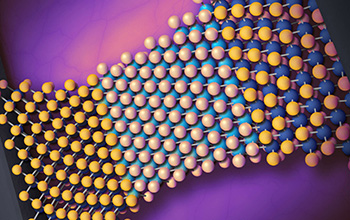Multimedia Gallery
2D material is used to create hybrid phase-change memristors
A rendering of a 2D material strategically strained to lie precariously between two different crystal phases. Researchers are using the material to create hybrid phase-change memristors, which operate by applying voltage to a thin filament between two electrodes, which offer fast, low-power and high-density computing memory.
[Research supported by U.S. National Science Foundation grants OMA 1936250, ECCS 1942815 and DMR 1719875.]
Learn more in the University of Rochester news story Straining memory leads to new computing possibilities. (Date of image: 2023; date originally posted to NSF Multimedia Gallery: Dec. 20, 2023)
Credit: University of Rochester illustration/Michael Osadciw
Images and other media in the National Science Foundation Multimedia Gallery are available for use in print and electronic material by NSF employees, members of the media, university staff, teachers and the general public. All media in the gallery are intended for personal, educational and nonprofit/non-commercial use only.
Images credited to the National Science Foundation, a federal agency, are in the public domain. The images were created by employees of the United States Government as part of their official duties or prepared by contractors as "works for hire" for NSF. You may freely use NSF-credited images and, at your discretion, credit NSF with a "Courtesy: National Science Foundation" notation.
Additional information about general usage can be found in Conditions.
Also Available:
Download the high-resolution JPG version of the image. (254.9 KB)
Use your mouse to right-click (Mac users may need to Ctrl-click) the link above and choose the option that will save the file or target to your computer.



